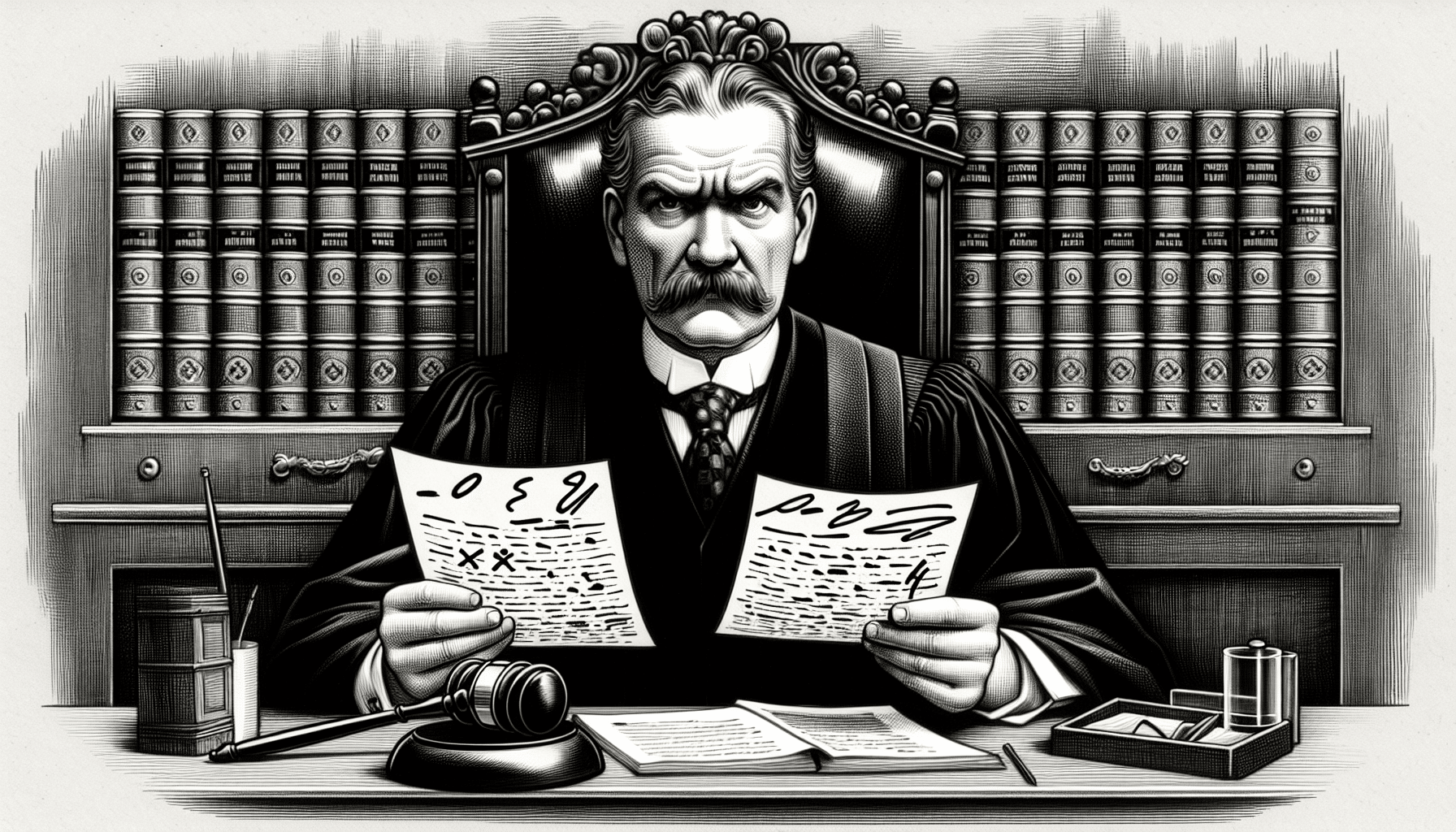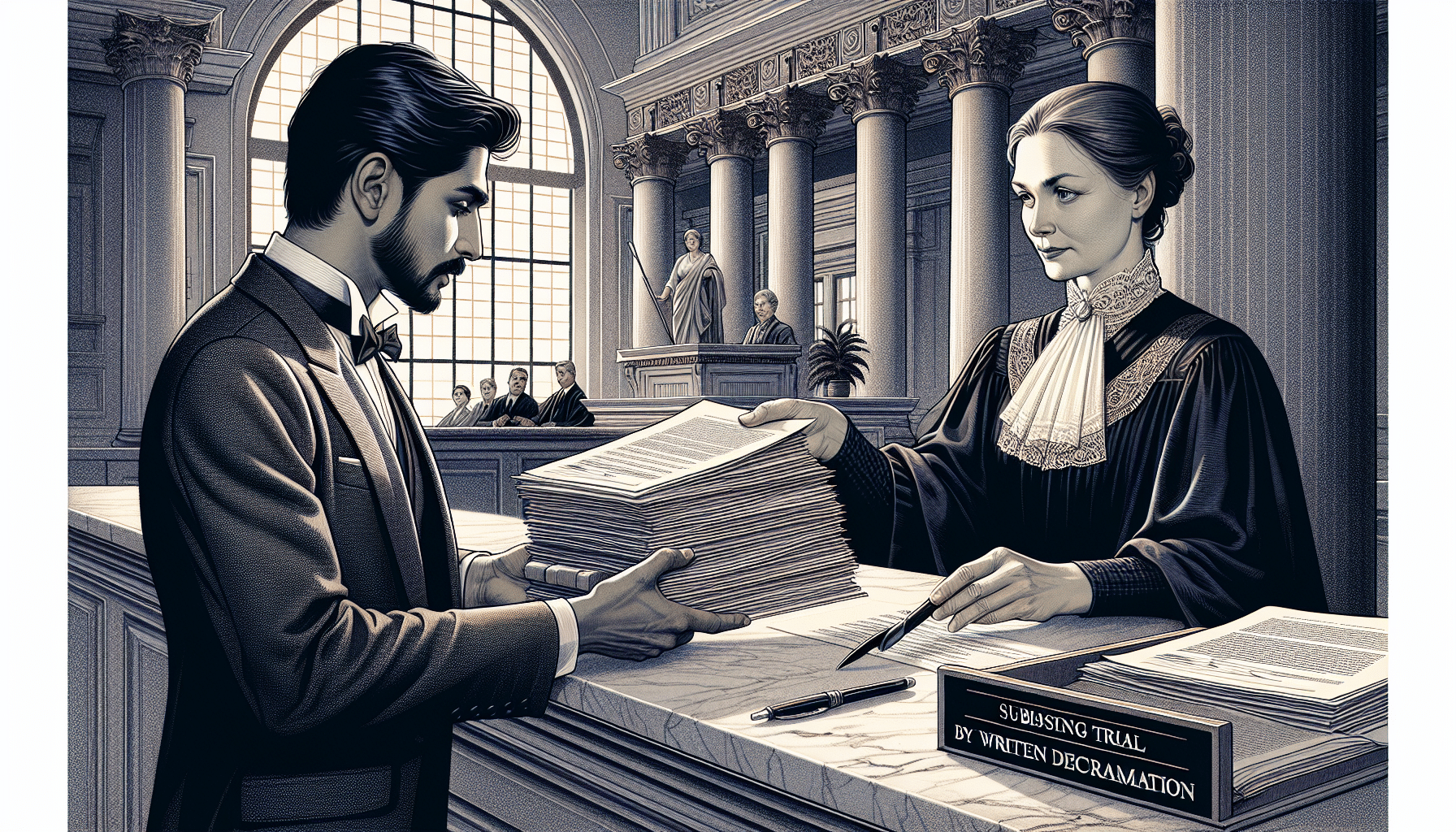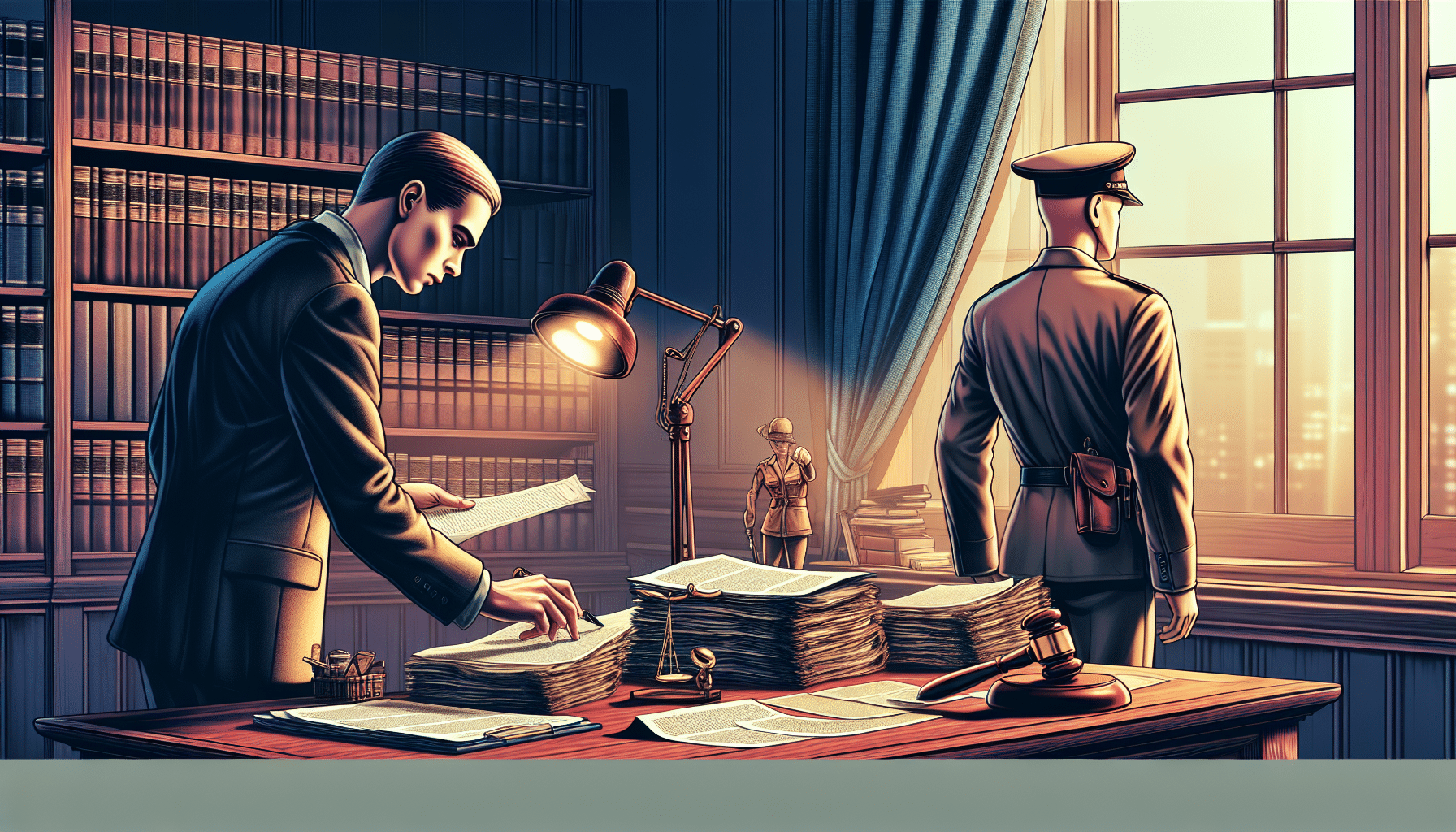Mastering the Process: How to Write a Trial by Written Declaration in California – Tips & Templates
Struggling with a traffic ticket in California? Learn how to write a trial by written declaration that can sway a judge without ever going to court. This guide cuts right to the chase, equipping you with the essentials of structuring sound arguments and compiling persuasive evidence, so you can submit your declaration with confidence. Whether you’re addressing minor oversights or tackling significant defenses, the forthcoming sections provide a blueprint for effectively disputing your citation.
Key Takeaways
- A trial by written declaration in California allows individuals to contest traffic tickets by sending a written statement and evidence to the court, bypassing the need for an in-person court trial.
- When filing a trial by written declaration, one must meet eligibility criteria, submit required documents and deposit bail, while effectively structuring and presenting their argument and evidence in the written statement.
- After submission, it’s important to confirm receipt with the court and understand the subsequent processes, including potential appeals like requesting a ‘trial de novo’ in case of an unsatisfactory decision or preparing for a formal trial appearance if necessary.
Understanding California’s Trial by Written Declaration

Let’s start by understanding what a trial by written declaration is. In simple terms, it’s a legal process that enables individuals to contest traffic tickets without having to appear in person at a court trial. Instead, they can send a written statement and any supporting evidence to the court, where a judge will review both their statement and the officer’s statement before making a decision.
The process starts with the defendant filing a formal request and depositing the bail amount by a specified due date. The specific court handling the traffic ticket case provides detailed instructions on how to request a trial by written declaration, including submission methods and fees.
It’s important to remember that this is not a “get out of jail free” card to be used recklessly. A trial by written declaration is a serious legal procedure, and like any court trial, it requires a strong and convincing argument to win. But with the right guidance and preparation, it can be a powerful tool in your arsenal against traffic tickets.
Eligibility Criteria for Trial by Written Declaration
So, who exactly is eligible for a trial by written declaration? The eligibility is determined by the guidelines provided under Vehicle Code section 40902, which establishes its specific use for contesting certain traffic infractions.
To be eligible, you must submit a written request to the court, file a Request for Trial by Written Declaration form, and deposit the required bail amount with the court. Once the court receives your request and bail, it will send the Notice and Instructions to the Arresting Officer and wait for the officer’s declaration to proceed with the trial.
Required Documents for Filing
Now that we’ve established eligibility, let’s take a look at the documents required for filing a trial by written declaration. First and foremost, you’ll need to file the Request for Trial by Written Declaration. In some cases, you may also need to file an Attached Declaration for additional written statements certified as true under state laws.
Supporting evidence, such as:
- the Notice to Appear
- business records
- receipts
- the arresting officer’s sworn statement
should also be submitted along with your declaration. Remember, you’re required to deposit bail in the amount of the fine when filing your request by the due date provided by the court clerk. And don’t forget to follow the court’s specific processes and instructions for submission, which may include options for online filing or sending documents by mail.
Crafting Your Written Statement

Now that the legalities are out of the way, let’s get to the heart of the matter – crafting your written statement. This is where you present your case, arguing why you believe the traffic ticket was wrongly issued. Keeping your statement brief, focused, and clear ensures it’s easy for the judge to understand and follow.
An effective strategy to strengthen your argument is to anticipate and address potential counterarguments in your statement. This demonstrates a comprehensive perspective, showing that you’ve considered all aspects of the issue. Remember, your written statement is your voice in this trial – make sure it speaks loud and clear.
Structuring Your Argument
Structuring your argument is key to presenting a persuasive case. Start by organizing your main arguments and supporting evidence in a logical sequence. This will help to improve clarity and make your argument easier to follow.
Make sure your arguments are presented clearly and concisely, using specific examples and evidence. Keep the focus on the relevancy of the examples and evidence provided, and avoid including irrelevant information in your written argument.
Presenting Evidence Effectively
Evidence is the backbone of your case – but simply having it isn’t enough. You need to present it effectively. This means including relevant evidence such as photos or witness statements with your written declaration and ensuring they’re properly labeled for easy identification.
But don’t stop there. Provide a clear explanation of how each piece of evidence supports your argument. This will illustrate its relevance and make your case more compelling. Remember, every piece of evidence is a brick in the wall of your defense – make sure it’s placed right.
The Legal Nuances: Avoiding Common Pitfalls

Now that we’ve covered the basics of writing a trial by written declaration, let’s dive into some legal nuances and common pitfalls. One of the most important things to remember is that it’s the judge’s responsibility to determine guilt based on the law and evidence presented. It’s not your job to justify your actions.
A common mistake in a trial by written declaration is admitting guilt or providing justifications for the violation, which can be seen as a form of guilty plea. This can compromise your case and lead to an unfavorable judgment. Keep your focus on presenting a strong argument and providing evidence to support your stance.
Navigating Vehicle Code and Local Ordinances
Understanding the vehicle code and local ordinances relevant to your case is crucial. It not only helps you understand the specific legal requirements of your jurisdiction but also enables you to cite the specific vehicle code section relevant to the alleged violation in your written declaration.
This can significantly strengthen your argument. Just make sure that the laws you cite, including the basic speed law, are relevant to the violation and accurately understood. After all, knowledge is power, and in this case, it can be the power to successfully contest your traffic ticket and avoid potential speeding tickets.
Addressing Automated Enforcement Systems
If your ticket was issued by an automated enforcement system, there are specific strategies you can use to challenge it. For instance, you can present questions regarding the calibration of the detection equipment, which can be a key defense strategy. You should also address the visibility and clarity of signage related to the violation, as unclear or poorly placed signs could invalidate your ticket.
The timing of yellow lights is another regulated aspect of traffic control that you could challenge. In addition to these technical issues, legal arguments can also be made against automated enforcement systems, such as red light cameras, for potentially violating state laws or constitutional rights.
Submission Strategies: Ensuring Your Declaration Is Heard

Submitting your trial by written declaration is not just about sending it off and hoping for the best. There are strategies you can employ to ensure your declaration is heard. You can make your request for a trial by written declaration through a formal written request to the courts or by visiting the clerk’s office during non-peak hours. Just make sure to meet the deadline outlined on the notice or ticket.
Your written declaration and supporting evidence can be submitted by mail, or online if the court offers this service. Always follow the court’s specific processes and instructions for submission. When submitting, ensure to include the completed court form detailing the incident, any evidence to support your case, and make any necessary payments by the due date.
Timing and Delivery
When it comes to timing and delivery, a few key strategies can save you a lot of headache. Firstly, make extra copies of all your forms. You never know when you might need them, especially if the sent copy gets lost.
In terms of delivery, using certified mail is recommended. It serves as proof of delivery before the due date, which can be crucial if there are any disputes about whether your documents were received on time.
Confirming Receipt and Following Up
After you’ve submitted your trial by written declaration, it’s important to confirm that the court house has received it. If you don’t receive confirmation, don’t panic – the clerk is required to extend the court date by 25 calendar days if a written request for a trial by written declaration is received by the original appearance date.
Following up is not just about peace of mind; it’s also about ensuring that your case is progressing as it should. Stay proactive, and don’t hesitate to reach out to the court if you need to.
After Submission: What to Expect and Next Steps
So, what happens after you’ve submitted your trial by written declaration? The court clerks will notify the issuing officer to submit their statement by a specified deadline. A judge will then review both your statement and the officer’s submission to make a decision.
You will receive the Decision and Notice of Decision within 90 calendar days following the trial by written declaration due date. If you’re found not guilty or if your fine is reduced, you’ll receive a refund for any posted bail.
If you’re not satisfied with the initial decision, you have the right to request a new trial, known as a ‘trial de novo’.
Understanding the Judge’s Decision
When you receive the judge’s decision, it’s crucial to understand what it means. The decision can include any lawful fine, assessment, or other penalty, and it’s not restricted to the bail amount paid. Judges make their ruling based on the written statements provided by both you and the officer from the law enforcement agency, considering all submitted statements and evidence to reach a decision.
If you’re found not guilty or if your fine is reduced, you’re entitled to a refund that encompasses any bail money paid during the request for a trial by written declaration.
Options if Found Guilty
If you’re found guilty, it’s not the end of the road. You have options. You can file a Request for New Trial (Trial de Novo) within 20 calendar days following the delivery or mailing of the Decision and Notice of Decision. The court is obligated to set a trial date within 45 calendar days upon your request.
If the verdict remains guilty, the court retains the bail money, and the traffic infraction is recorded on your driving record. However, if you attend traffic school, it may mask points from being added to your license after a guilty verdict.
Preparing for Possible Court Appearance

Sometimes, a trial by written declaration may lead to a formal trial that necessitates a court appearance. If this happens, you need to be prepared. Be ready to cross-examine the police officer involved in your case, who will also have the opportunity to provide a declaration during the trial by written declaration.
When preparing for a potential in-person trial, follow these steps:
- Meticulously compile all relevant evidence.
- Ensure it’s clearly explained and properly attached to the court forms.
- Remember, the more prepared you are, the more confident you’ll be when presenting your case.
Maximizing Chances for a Favorable Outcome
When it comes to a trial by written declaration, there are a few strategies you can use to maximize your chances for a favorable outcome. One such strategy is using a declaration tailored to your case with specific facts and evidence. This increases the chances of a successful outcome.
Another strategy is asserting that the officer must meet the burden of proof beyond a reasonable doubt. This can be an effective way to challenge their evidence and can create doubt in the judge’s mind about the officer’s case.
In the end, no matter how well you’ve prepared, the outcome of your trial by written declaration is in the hands of the judge. However, the strategies and tips covered in this article can help you present the best possible case and increase your chances of success.
Summary
In conclusion, a trial by written declaration is a unique and valuable tool for contesting traffic tickets in California. It requires careful preparation, a well-structured argument, and a clear understanding of the legalities involved. But with the right guidance, it can be a powerful ally in your fight against traffic violations.
Remember, every case is unique, and the tips and strategies discussed here may need to be tailored to fit your specific circumstances. However, they provide a strong foundation to start from. Good luck, and remember – the road to justice may be long, but it’s a journey worth taking.
Frequently Asked Questions
What is a trial by written declaration?
A trial by written declaration in California allows individuals to contest traffic tickets in writing, without having to appear in person at a court trial. Both the defendant and the officer submit written statements for the judge to review before making a decision.
Who is eligible for a trial by written declaration?
To be eligible for a trial by written declaration, you must submit a written request to the court, file a Request for Trial by Written Declaration form, and deposit the required bail amount with the court. This is determined by the guidelines provided under Vehicle Code section 40902.
How should I structure my written statement for a trial by written declaration?
Organize your written statement logically, listing key points and supporting evidence. Make it clear, concise, and include specific examples and evidence to support your argument.
What happens after I’ve submitted my trial by written declaration?
After submitting your trial by written declaration, the court clerks will notify the issuing officer to submit their statement, and a judge will review both statements to make a decision. You can expect to receive the Decision and Notice of Decision within 90 calendar days following the due date.
What can I do if I’m found guilty?
If you’re found guilty, you can file a Request for New Trial within 20 days. If the verdict stands, attending traffic school may prevent points from being added to your license.




